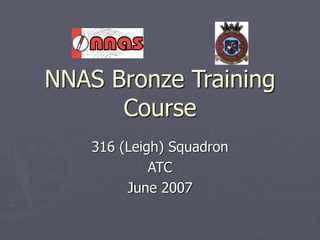
Nnas training for 316 Squadron
- 1. NNAS Bronze Training Course 316 (Leigh) Squadron ATC June 2007
- 2. Syllabus ► Maps ► Map Symbols, Scales ► Grid References ► Compass ► Orienting the Map (facing the right way) ► Navigating Using Linear Features (following lines) ► Judging Distances ► Relocation (getting “found” after getting “lost”) ► Plan a Walk ► Country Code & Right to Roam
- 3. Maps
- 4. Example Map
- 5. What is a map ►A Map is a flat representation of a lumpy surface ►It provides an approximate plan of an area Some things are not shown Some things are lumped together Some things are bigger than they really are
- 6. Local Map
- 8. Railways
- 10. Water Features
- 11. Roads
- 14. Boundaries and Antiquities (edges and old stuff)
- 16. Scales ► A map is smaller than the area it represents ► Therefore a distance on the map presents a bigger distance in real life ► OS Landranger 1:50,000 1cm = 0.5 km or 2cm 1 km ► OS Outdoor leisure 1:25,000 1cm = 0.25km or 2cm 0.5km or 4cm = 1km ► Herveys 1:40,000 1cm = 0.4km or 2cm 0.8km or 2.5 cm = 1km
- 17. Grid References
- 18. Grid References
- 19. Orientating the Map Pointing the right way
- 20. Why do it? ► Make it easier to work out where you’re going ► Check you’re where you think you are ► Two ways With compass Looking at ground around you
- 22. Orienting the map to the terrain
- 24. What is a Linear Feature? ► Path, Road ► Edge of a wood or forest ► Lake or sea shore, river, stream or canal ► Ridge ► Pylons, fences, pipelines
- 25. Using a linear feature ► Walk along it! ►But… Check your direction with the compass and map Work out when to leave the feature
- 28. On a Map ► 1:50,000 scale 1 cm = 0.5 km 2 cm = 1 km (each grid square is 2 cm/1 km) ► 1:25,000 scale 1 cm = 0.25 km 2 cm = 0.5 km 3 cm = 0.75 km 4 cm = 1 km (each grid square is 4 cm/1 km) ► You can… Measure (ruler, compass edge, etc. hard but accurate) Count grid squares (quick and easy but inaccurate)
- 29. In Real Life ► Use features that are known lengths or distances Points on the map that are easily identifiable E.g. I know the road is 3 km long, the bridge is half way a long, so it’s 1.5 km ► Scale up from distances you know Football field, hockey pitch, length of your street It’s about 5 time further than the end of my street. My street is 100m long, so it is about 0.5 km away
- 30. In Real Life…
- 31. Relocation Or the opposite of getting lost…
- 32. Getting Lost ► Everyone does it… ► Trick is to recognise when you are lost! ► Suspect you are lost when… You’ve not at an expected check point when you expected to see it What you’re seeing doesn’t match what’s on the map You’re walking downhill instead of uphill or vice versa You’re not walking in the right compass direction
- 33. Relocating ► Gather information How long since the last known position? ►Lets you work out how far you might have moved What compass direction did we walk? What features can we see? ► Slopes, rivers, hills, forests, roads, bridges, buildings? What distinguishing features will help me recognise where I am? ►Sharp bends, shape of forests What bearing are these features from me?
- 34. Confirming Position Once you have an idea where you might, you need a plan. Choice are: 1. Carry on, but check that the map and terrain now match up 2. Move towards a clear feature (e.g. road) for easier navigation 3. Retrace your steps back to your last known position
- 35. Planning a Route
- 36. Route Planning Questions ► Where do I start and where do I finish? ► How will I navigate the route? Any linear features to help? Any significant landmarks ► What will the terrain be like? Too much climbing slows you down and tires you out Swamps, cliffs, loose rocks, etc. make walking difficult Navigating through forests is hard ► Is there any thing I want to see on the way? ► How long will it take?
- 38. Distance 1.55 km Climb 129m Descent 76 m Time 1:31 hrs Distance 2.75 km Climb 98 m Descent 40 m Time 1:44 hrs The longer route only takes 13 minutes more despite being 1.2 km longer. Most direct is not always the fastest way to go.
- 39. End
